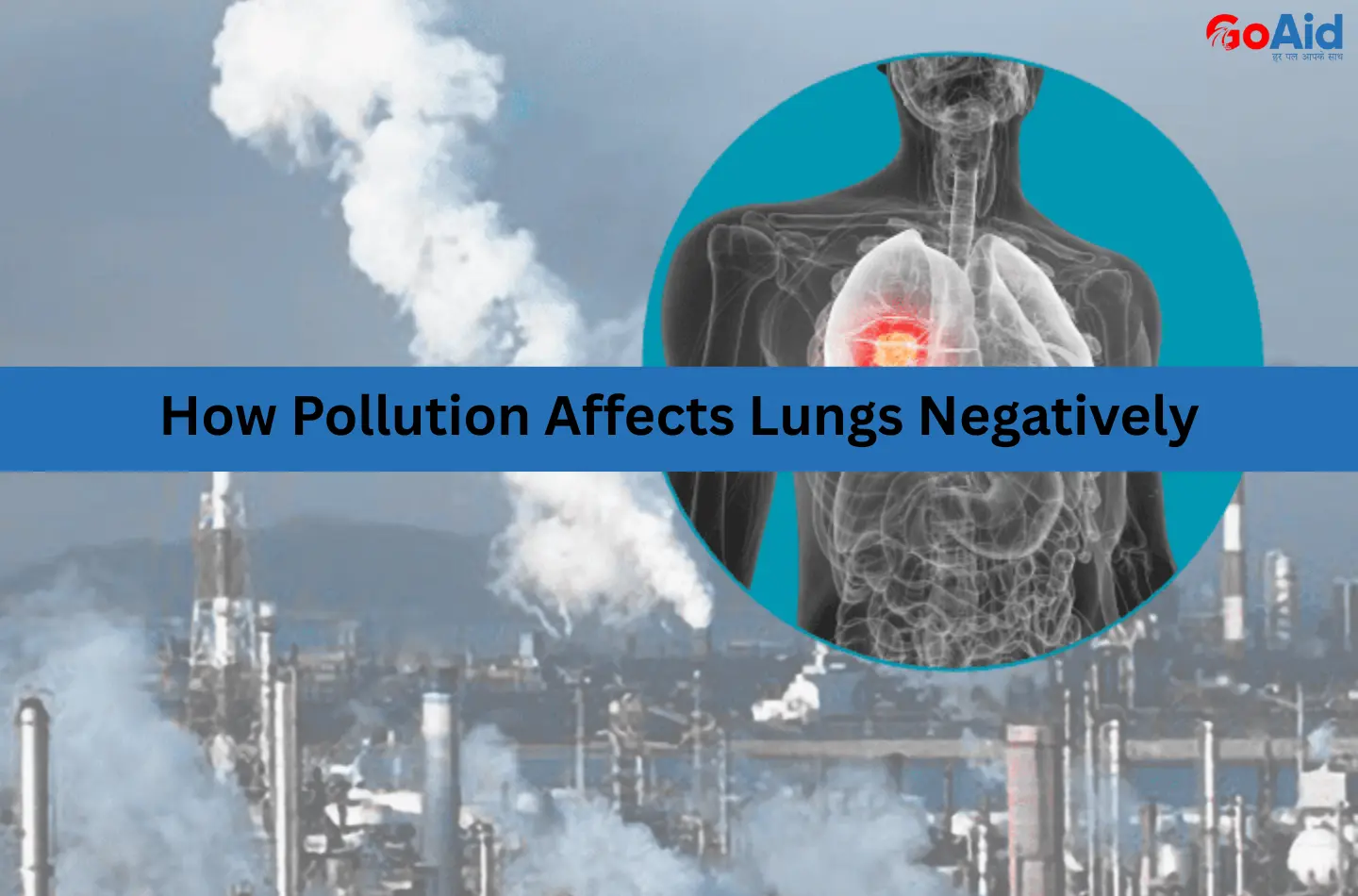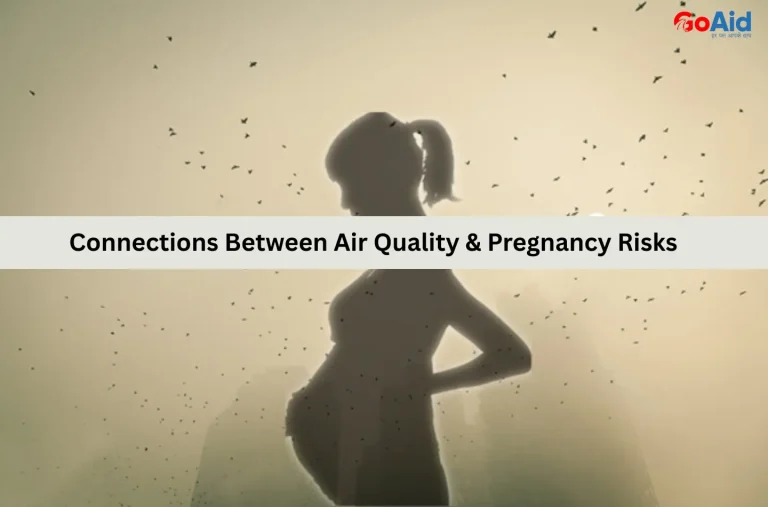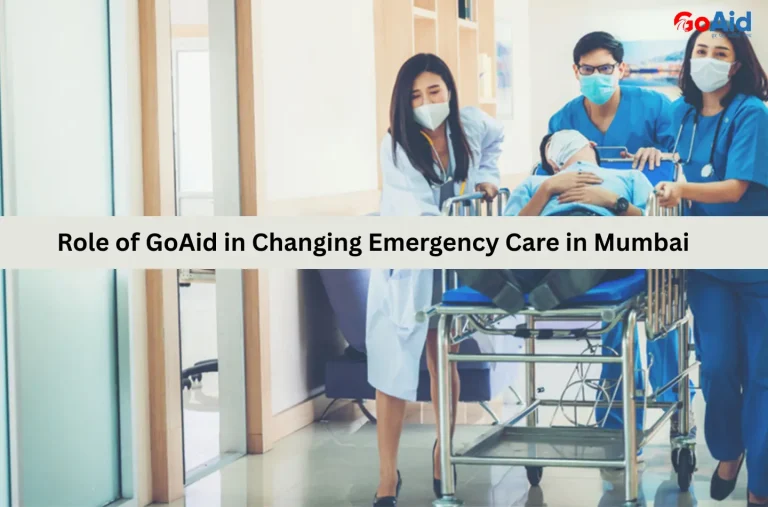The rising levels of air pollution are silently damaging the lungs of millions across India, especially in metro cities where air quality often reaches hazardous levels. Polluted air contains harmful particles and gases that can irritate the airways, reduce oxygen levels, and lead to chronic respiratory diseases like asthma, bronchitis, and even lung cancer.
This is why, in this blog, we have provided you all the details about how polluted air damages the lungs, major diseases caused by it, when to call an ambulance, GoAidŌĆÖs emergency support, and prevention tips for better lung health. Are you willing to know about all these points in detail? Then read this blog to the end.
So, letŌĆÖs start ŌĆō
How Does Polluted Air Enter and Damage the Respiratory System?
Airborne pollutants enter the body through inhalation, gradually affecting respiratory organs and overall lung function. This leads to acute and chronic health issues.
- Inhalation of Fine Particles (PM2.5):
Tiny particles bypass nasal filters and reach deep into the lungs. This causes inflammation. This reduces oxygen absorption, and irritating airways. This leads to chronic respiratory conditions over time.
- Exposure to Nitrogen Dioxide (NOŌéé):
Gases from vehicle emissions inflame the airways, exacerbate asthma, and increase susceptibility to respiratory infections, especially in urban populations.
- Ozone Penetration:
Ground-level ozone reacts with lung tissues. This causes irritation, coughing, and reduced lung function, particularly affecting vulnerable groups like children and the elderly.
- Sulfur Dioxide Effects:
This gas irritates the nose, throat, and lungs. This triggers bronchoconstriction and aggravates conditions like asthma and chronic bronchitis.
- Carbon Monoxide Binding with Hemoglobin:
CO reduces oxygen-carrying capacity in the blood. This strains the respiratory and cardiovascular systems and impairing tissue oxygenation, which can worsen chronic lung diseases.
- Allergens and Pollens in Polluted Air:
Combined with pollutants, allergens penetrate the lungs more easily. This triggers immune responses, inflammation, and respiratory distress in sensitive individuals.
- Toxin-Induced Mucus Production:
Pollutants stimulate excessive mucus secretion in airways. This leads to blockage, coughing, and discomfort, which impairs normal respiratory function.
- Chronic Inflammation of Airways:
Repeated exposure causes ongoing inflammation, airway remodeling, and narrowing. This increases the risk of chronic obstructive pulmonary disease (COPD) and other disorders.
- Weakened Lung Defense Mechanisms:
Air pollution impairs cilia function in the respiratory tract. This reduces the lungsŌĆÖ ability to clear pathogens and particulates. This raises infection risks.
- Triggering Oxidative Stress:
Pollutants generate free radicals that damage lung tissues, promote inflammation, and contribute to long-term respiratory illnesses and reduced pulmonary capacity.
Read More: Connections Between Air Quality & Pregnancy Risks
Major Lung Diseases Caused by Poor Air Quality
Poor air quality significantly contributes to lung diseases, ranging from mild irritation to life-threatening chronic conditions. This requires timely medical attention.
- Asthma:
Air pollution triggers airway inflammation. This causes wheezing, shortness of breath, and severe asthma attacks that may require Emergency Care for Asthma Patients.
- Chronic Obstructive Pulmonary Disease (COPD):
Long-term exposure leads to irreversible airway obstruction, persistent cough, mucus production, and breathing difficulties. This reduces overall lung function.
- Bronchitis:
Inflammation of bronchial tubes due to pollutants causes coughing, mucus buildup, and difficulty in breathing, sometimes progressing to chronic bronchitis.
- Pneumonia:
Polluted air increases susceptibility to bacterial and viral infections in the lungs. This leads to inflammation, fever, coughing, and fluid accumulation.
- Lung Cancer:
Carcinogenic pollutants like benzene and fine particulates can trigger abnormal cell growth. This increases lung cancer risk over long-term exposure.
- Emphysema:
Air pollution destroys alveoli. This causes enlarged air sacs, reduced oxygen exchange, and shortness of breath, often seen in smokers and urban residents.
- Pulmonary Fibrosis:
Toxins in polluted air can scar lung tissues. This results in stiff lungs, chronic coughing, and progressive breathing difficulty.
- Allergic Rhinitis with Respiratory Complications:
Pollutants exacerbate nasal and airway inflammation. This causes sneezing, congestion, and secondary lung issues in sensitive individuals.
- Interstitial Lung Disease (ILD):
Pollutants irritate and inflame the interstitium of the lungs. This leads to tissue thickening, impaired oxygen absorption, and chronic breathing problems.
- Acute Respiratory Distress Syndrome (ARDS):
Severe exposure to toxic pollutants can trigger fluid accumulation in the lungs. This causes critical breathing difficulty that requires immediate GoAid Emergency for Breathing Issues.
Also Read: Important of a Fast Ambulance in a Cardiac Arrest
When Should You Call an Ambulance for Breathing Difficulty?
Breathing difficulties can quickly become life-threatening. Knowing when to call a GoAid Ambulance for Respiratory Care ensures timely intervention and prevents serious complications.
- Severe Shortness of Breath:
If breathing becomes rapid, labored, or visibly strained, it may indicate respiratory failure or acute asthma. Immediate ambulance support allows paramedics to administer oxygen and monitor vital signs en route to the hospital.
- Chest Pain with Breathing Difficulty:
Difficulty breathing accompanied by chest pain could signal heart or lung emergencies like pulmonary embolism. Calling a GoAid Emergency for Breathing Issues ensures rapid transport and advanced care before complications escalate.
- Sudden Wheezing or Coughing Fits:
Intense wheezing or persistent coughing, especially in asthma or COPD patients, can obstruct airflow. Trained paramedics can administer nebulization, oxygen, and first-line medications during transit.
- Bluish Lips or Fingers:
Cyanosis indicates oxygen deprivation and is a serious emergency. GoAid Ambulance for Respiratory Care provides immediate oxygen therapy and monitoring to prevent organ damage.
- Unresponsiveness or Severe Fatigue:
If the patient is unusually lethargic or losing consciousness while struggling to breathe, it is a critical situation. Quick ambulance support ensures oxygen delivery, vital monitoring, and hospital transfer without delay.
GoAidŌĆÖs Specialized Ambulance Services for Respiratory Patients
GoAid provides specialized ambulances equipped for advanced respiratory care. This ensures patients with breathing difficulties receive timely and effective medical support.
Oxygen Ambulance:
Equipped with high-flow oxygen cylinders, ventilators, and pulse oximeters, oxygen ambulances stabilize patients with hypoxia or acute respiratory distress during transit. This service ensures continuous oxygen supply until hospital admission.
ALS Ambulance:
Advanced Life Support (ALS) ambulances carry cardiac and respiratory monitoring devices, emergency medications, and trained paramedics capable of handling severe respiratory emergencies, asthma attacks, or sudden respiratory failure effectively.
ICU Ambulance:
For critically ill respiratory patients, ICU ambulances function as mobile intensive care units, equipped with ventilators, monitors, infusion pumps, and advanced life support tools. Paramedics provide continuous monitoring, emergency interventions, and specialized care throughout the journey. This ensures maximum safety.
Know More: Difference between BLS Ambulance and ALS Ambulance
Prevention Tips for Maintaining Lung Health
Maintaining lung health is essential, especially in polluted environments, and adopting simple preventive measures can reduce respiratory risks significantly.
- Avoid Exposure to Polluted Air:
Stay indoors during peak pollution hours and avoid highly trafficked areas to minimize inhalation of harmful particles.
- Use Masks in Polluted Environments:
Wear N95 or equivalent masks when stepping outside to filter fine particulate matter and pollutants.
- Install Air Purifiers at Home:
HEPA filters or air purifiers reduce indoor pollutants. This protects lungs from harmful particles.
- Regular Exercise Indoors or in Clean Areas:
Physical activity strengthens lung capacity while minimizing exposure to outdoor pollutants.
- Stay Hydrated:
Drinking water helps thin mucus. This keeps airways clear and reducing pollutant accumulation in the lungs.
- Avoid Smoking and Secondhand Smoke:
Tobacco smoke damages lung tissues and increases susceptibility to pollution-related respiratory issues.
- Consume Antioxidant-Rich Foods:
Fruits and vegetables help combat oxidative stress caused by pollutants. This protects lung cells.
- Regular Medical Checkups:
Early detection of respiratory issues ensures timely interventions and reduces long-term lung damage.
- Proper Ventilation at Home:
Ensure indoor spaces are well-ventilated to avoid the accumulation of dust and chemical pollutants.
- Use Public Transport or Carpool:
Reducing personal vehicle use decreases overall emissions, indirectly improving air quality and lung health.
Long-Term Solutions to Improve Air Quality in Cities
Improving urban air quality requires systematic planning and sustainable interventions for healthier city living.
- Promote Public Transport:
Encouraging buses, trains, and metro systems reduces the number of private vehicles. This lowers vehicular emissions significantly.
- Adopt Clean Energy Sources:
Switching to solar, wind, and hydro energy decreases reliance on fossil fuels. This reduces air pollutants and greenhouse gases.
- Increase Green Cover:
Planting trees, creating parks, and maintaining urban forests help filter pollutants, absorb COŌéé, and improve oxygen levels.
- Implement Strict Vehicle Emission Norms:
Regular checks and emission regulations ensure vehicles meet standards. This minimizes harmful gases released into the atmosphere.
- Encourage Electric Vehicles (EVs):
Subsidies and infrastructure for EVs reduce pollution from petrol and diesel engines. This promotes cleaner urban air.
- Industrial Pollution Control:
Mandating factories to install filters, scrubbers, and adopt cleaner production processes significantly reduces toxic emissions.
- Public Awareness Campaigns:
Educating citizens about pollution, its health effects, and preventive measures fosters behavioral changes that collectively improve air quality.
Conclusion
In conclusion, we have provided you all the details about How Polluted Air Affects the Lung: Symptoms, Causes & Prevention. Maintaining lung health, recognizing symptoms, and seeking timely GoAid Ambulance for Respiratory Care can prevent serious complications.┬Ā
By following preventive tips and supporting long-term urban air quality solutions, individuals and communities can reduce pollution exposure and safeguard respiratory health for themselves and future generations.
















